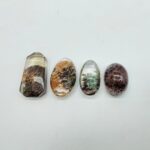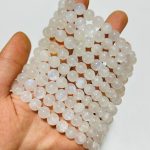Diamonds, with their mesmerizing clarity and captivating brilliance, have captivated the hearts and imaginations of humankind for centuries. These precious gemstones embody a timeless allure that transcends temporal boundaries. In the tapestry of crystal lore, diamonds stand alone as the epitome of clarity and enduring beauty.

Birth of a Diamond: A Journey of Time and Pressure
Diamonds, the hardest known natural material, are forged in the Earth’s depths under extreme heat and pressure. Carbon atoms, subjected to these extraordinary conditions, bond together in a crystalline lattice, forming the nucleus of a diamond. Over millions of years, as geological forces shift and move, diamonds are slowly transported to the Earth’s surface through volcanic eruptions or kimberlite pipes.
Clarity: The Essence of a Diamond’s Beauty
Clarity measures the presence or absence of inclusions and blemishes within a diamond. The fewer inclusions, the clearer the diamond. Gemologists use a 10-point scale to assess diamond clarity, ranging from “flawless” to “included,” with various intermediate grades.
- Flawless (FL): No inclusions or blemishes visible under 10x magnification.
- Internally Flawless (IF): No inclusions visible under 10x magnification, but tiny blemishes may be present.
- Very, Very Slightly Included (VVS1, VVS2): Tiny inclusions that are difficult to see under 10x magnification.
- Very Slightly Included (VS1, VS2): Minor inclusions that are visible under 10x magnification.
- Slightly Included (SI1, SI2): Inclusions that are noticeable under 10x magnification.
- Included (I1, I2, I3): Obvious inclusions that may affect the diamond’s appearance.
Color: Nurtured by Nature’s Palette
Diamonds, despite their renown for clarity, exhibit a subtle spectrum of colors. The most coveted are colorless diamonds, which command a premium due to their rarity. As the yellow hues deepen, diamonds may be graded as near colorless, faint yellow, light yellow, or yellow.
Applications: Where Clarity Shines
The exceptional clarity of diamonds extends their utility beyond adornment. Their unique properties have propelled them into a diverse range of applications:
- Jewelry: Diamonds are the heart of engagement rings and adorn fine jewelry, symbolizing love, promise, and unwavering commitment.
- Precision Instruments: Their unparalleled clarity and resistance to wear make diamonds ideal for use in cutting tools, drills, and other precision instruments.
- Lasers: Industrial diamond lasers emit high-power beams used in a myriad of applications, including surgery, manufacturing, and scientific research.
- Medical Equipment: The clarity of diamonds facilitates their use in scalpels, surgical implants, and other medical devices that demand precision and longevity.
Tables for Clarity
Diamond Clarity Table
| Grade | Description |
|---|---|
| Flawless (FL) | No inclusions or blemishes visible under 10x magnification |
| Internally Flawless (IF) | No inclusions visible under 10x magnification, but tiny blemishes may be present |
| Very, Very Slightly Included (VVS1, VVS2) | Tiny inclusions that are difficult to see under 10x magnification |
| Very Slightly Included (VS1, VS2) | Minor inclusions that are visible under 10x magnification |
| Slightly Included (SI1, SI2) | Inclusions that are noticeable under 10x magnification |
| Included (I1, I2, I3) | Obvious inclusions that may affect the diamond’s appearance |
Diamond Color Table
| Grade | Description |
|---|---|
| Colorless | No discernible hue or tint |
| Near Colorless | Very faint yellow hue, difficult to detect with the naked eye |
| Faint Yellow | Slight yellow hue, but still considered colorless to the untrained eye |
| Light Yellow | More pronounced yellow hue, but still within the acceptable range for colorless diamonds |
| Yellow | Distinct yellow hue, easily discernible to the naked eye |
Diamond Application Table
| Application | Description |
|---|---|
| Jewelry | Engagement rings, necklaces, earrings, bracelets |
| Precision Instruments | Cutting tools, drills, precision instruments |
| Lasers | Industrial diamond lasers used in surgery, manufacturing, and research |
| Medical Equipment | Scalpels, surgical implants, medical devices demanding precision and longevity |
Diamond Clarity Vs. Color Table
| Clarity | Colorless | Near Colorless | Faint Yellow | Light Yellow | Yellow |
|---|---|---|---|---|---|
| Flawless | Premium value | Exceptional value | Excellent value | Good value | Fair value |
| Internally Flawless | High value | Very good value | Good value | Fair value | Acceptable value |
| Very, Very Slightly Included | Good value | Fair value | Acceptable value | Modest value | Low value |
| Very Slightly Included | Fair value | Acceptable value | Modest value | Low value | Insignificant value |
| Slightly Included | Acceptable value | Modest value | Low value | Insignificant value | No value |
| Included | Low value | Insignificant value | No value | No value | No value |
FAQs: Demystifying Diamonds
-
What is the difference between clarity and color in diamonds?
Clarity measures the presence or absence of inclusions and blemishes, while color refers to the hue or tint of a diamond. -
Which is more important, clarity or color?
Both clarity and color contribute to the value of a diamond. However, in general, clarity is considered more important as it affects the diamond’s brilliance and transparency. -
Is it possible to find a flawless diamond?
Flawless diamonds are extremely rare and command a significant premium. According to the Gemological Institute of America (GIA), only about 2% of all diamonds are graded as flawless. -
Can diamond clarity be improved?
Inclusions and blemishes cannot be removed from a diamond. However, some treatments, such as laser drilling, can improve the appearance of certain inclusions by making them less visible. -
What is the best way to clean a diamond?
Use a mild dishwashing liquid diluted in warm water. Soak the diamond for 20-30 minutes, then gently brush it with a soft-bristled toothbrush. Rinse thoroughly and pat dry with a lint-free cloth. -
How often should I get my diamond inspected?
Diamonds can accumulate dirt and oil over time, which can affect their brilliance. It is recommended to have your diamond inspected by a qualified jeweler every six months to a year for cleaning and maintenance.
Conclusion: The Enduring Allure of Clarity
Clear crystals, exemplified by diamonds, captivate our imagination with their pristine beauty and enduring allure. Their multifaceted applications, from exquisite adornments to cutting-edge technologies, showcase their remarkable versatility. As we delve into the world of clear crystals, we marvel at their enduring brilliance, a testament to the timeless fascination with clarity and the boundless possibilities it inspires.




























